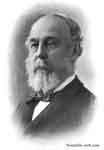|
|
Asaph Hall III (October 15, 1829 – November 22, 1907) was an American astronomer who is most famous for having discovered the moons of Mars (namely Deimos and Phobos) in 1877.[1] He determined the orbits of satellites of other planets and of double stars, the rotation of Saturn, and the mass of Mars.
Hall was born in Goshen, Connecticut, the son of Asaph Hall II, a clockmaker, and Hannah Palmer. His father died when he was 13, leaving the family in financial difficulty, so Asaph left school at 16 to become an apprentice to a carpenter. He later enrolled at the Central College in McGrawville, New York, where he studied mathematics. There he took classes from an instructor of geometry and German, Angeline Stickney. In 1856 they married. In 1856, he took a job at the Harvard College Observatory in Cambridge, Massachusetts, and turned out to be an expert computer of orbits. Hall became assistant astronomer at the US Naval Observatory in Washington DC in 1862, and within a year of his arrival he was made professor. In 1875 Hall was given responsibility for the USNO 26-inch (66-cm) telescope, the largest refractor in the world at the time. It was with this telescope that he discovered Phobos and Deimos in August 1877. He also noticed a white spot on Saturn which he used as a marker to ascertain the planet's rotational period. In 1884, he showed that the position of the elliptical orbit of Saturn's moon, Hyperion, was retrograding by about 20° per year. Hall also investigated stellar parallaxes and the positions of the stars in the Pleiades cluster. Hall was responsible for apprenticing Henry S. Pritchett at the Naval Observatory in 1875. On June 5, 1872 Hall submitted an article entitled "On an Experimental Determination of Pi" to the journal Messenger of Mathematics. The article appeared in the 1873 edition of the journal, volume 2, pages 113-114. In this article Hall reported the results of an experiment in random sampling that Hall had persuaded his friend, Captain O.C. Fox, to perform when Fox was recuperating from a wound received at the Second Battle of Bull Run. The experiment involved repetitively throwing at random a fine steel wire onto a plane wooden surface ruled with equidistant parallel lines. Pi was computed as 2ml/an where m is the number of trials, l is the length of the steel wire, a is the distance between parallel lines, and n was the number of intersections. This paper is a very early documented use of random sampling (which Nicholas Metropolis would name the Monte Carlo method during the Manhattan Project of World War II) in scientific inquiry. Hall retired from the Navy in 1891. He became a lecturer in celestial mechanics at Harvard University in 1896, and continued to teach there until 1901. Asaph and Angeline had four children. All graduated from Harvard University. His son Asaph Hall Jr also became an astronomer, Samuel Stickney Hall died at thirty after beginning a career in insurance, Angelo Hall became a Unitarian Minister and professor of mathematics at the US Naval Academy, and Percival Hall became the second president of Gallaudet University. Angeline Hall died in 1892. Asaph Hall married Mary Gauthier after he fully retired to Goshen, Connecticut in 1901. Asaph Hall died in November, 1907 while visiting his son, Angelo, in Annapolis, Maryland. Awards and honors He won the Lalande Prize of the French Academy of Sciences in 1878, the Gold Medal of the Royal Astronomical Society in 1879, the Arago Medal in 1893, and was made a Chevalier in the Ordre national de la Légion d'honneur (French Legion of Honor).[2] Hall crater on the Moon as well as Hall crater on the Martian moon Phobos[3] are named in his honor. Asteroid 3299 Hall is also named in his honor. Bibliography * Angelo Hall. An Astronomer's Wife: The Biography of Angeline Hall. Baltimore: Nunn & Company, 1908. [1] This book has been reprinted by BiblioLife (December 9, 2008). (includes a biographical chapter on Asaph Hall.) * Percival Hall. Asaph Hall, Astronomer. Self published, nd. (booklet, 46 pp.) * George William Hill. A Biographical Memoir of Asaph Hall, 1829-1907. Judd and Detwiler: Washington, DC, 1908.
1. ^ Blunck, Jürgen (2009). "The Satellites of Mars; Discovering and Naming the Satellites". Solar System Moons: Discovery and Mythology. Springer. p. 5. ISBN 3540688528, 9783540688525.
Retrieved from "http://en.wikipedia.org/"
|
|

